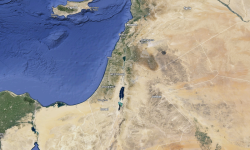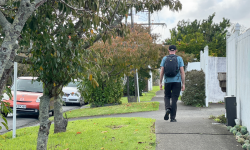
Charis Fotheringham works part-time as a communications assistant at the Baptist National Support Centre and part-time doing a Master of Management specialising in Sustainability. In this article, Charis explains the concept of sustainability and connects it to our call as Christians to bring gospel renewal.
Sustainability is difficult to capture in a definition. It’s like a genre with multiple interpretations, parodies and increasing popularity. But it’s not a new genre; it was around long before it got named. You can trace rhythms of sustainability in indigenous expressions of interconnectedness between people and the environment. Sustainability hums in communities that weave the care of local natural resources and shared well-being to continue together [1]. With the diversity of social, cultural, spiritual, and other contexts across the globe, sustainability has been conceptualised and communicated in many ways.
Sustainability became a ‘universal’ genre when it merged with economic and social development, creating the ‘sustainable development’ fusion, defined mainly by economists and academics. In 1987, the United Nations World Commission on Environment and Development popularised this fusion in the publication of ‘Our Common Future’ (The Brundtland Report). This report considers our world’s finite resources, addresses the conflicting relationship between increasing welfare and environmental degradation and presents sustainable development as a way of reconciliation [2]. Of all the interpretations of sustainability, the one introduced in the Brundtland Report seems to echo the most:
Development that meets the needs of the present without compromising the ability of future generations to meet their own needs [3].
The trio
With the increased interdisciplinary jamming of sustainability, three types of instruments became core to the genre: economic, environmental, and social. In theory, these are more appropriately named pillars or dimensions. This trio gave expression to the many colours of sustainability, going beyond the limits of ‘greening’. If a company uses recycled plastic and abuses the vulnerability of migrant workers through unauthorised subcontracting to increase short-term profits, is that company sustainable?
Writing an eco-friendly initiative into a migrant-unfriendly model for a financial outcome creates a lot of clashes (greenwashing) but not sustainability. Disjointing the health of the planet from the health of the people from the health of the organisations and systems that rely on and impact them comes at a higher cost than the work of tuning these interdependent relationships.
From rivers to veins
As the demand for automobiles, electric vehicles, telecommunication, energy storage devices and solar power systems increases, so does their use of lead-acid batteries [4]. The high recyclability of lead presents potential in sustainable development [4]. However, lead pollution, significantly contributed to by the production and informal recycling of lead-acid batteries, is a silent and severe issue worldwide. Lead is also used in textile dyeing processes [5] and found in consumer products such as toys and cosmetics [6]. It is highly toxic and poorly monitored in the developing countries that process it, contaminating water, soil and air [7].
Let’s zoom in on the infamous Citarum River, Indonesia. Over 20 years, a river that around 28 million people depend on was stripped of life by pollution, including heavy metal contamination [8]. Lead levels in this river are 1000 times the U.S. Environmental Protection Agency’s drinking water standard [9]. This poison laces the 340,000 tonnes of liquid waste discharged into the river by industry, significantly textiles, each day [8]. The communities here have little choice but to irrigate their farms and consume and bathe in toxic water. In an interview, a local woman explains,
You already know that the water is dirty, why still use it to take a bath [but] what else can we do? This is the only water we can use [8].
Zooming out, around one in three children in the world is affected by lead poisoning, which can impair their cognitive development and nervous system function [6]. The low- and lower-middle-income countries (LMICs) where most of these children live bear the further economic burden of IQ loss and increased mortality, morbidity and crime linked to childhood lead exposure [6] [10]. In 2019, 95.3% of global IQ loss from lead exposure and 90.2% of cardiovascular disease deaths from lead exposure occurred in LMICs [11]. These countries bore the brunt of the global US$6 trillion cost of lead exposure that year [11].
The colours of sustainability
This case highlights that sustainability is not just about cleaning up rivers and developing better waste management processes to reduce pollution. It weaves into restoring people’s livelihoods and ensuring children can grow and reach their potential. It is about enabling people to bring income into their families, contribute to their communities and participate in shaping the future. It’s creating a healthier and more inclusive economy.
Condemning the innocent
This case also exemplifies that current practices are direly unsustainable and going with the flow has a highly disproportionate impact. This ‘flow’ benefits the polluters and barriers the helplessly exposed, corroding a wider gap between the empowered and the vulnerable on our changing planet. On one side, it’s enhanced energy generation, personal transport, low-cost fashion and profiting from outsourcing cheap operations for few. On the other, it’s brain and central nervous system damage, comas, convulsions, permanent intellectual disabilities, and death for many of the world’s most vulnerable and innocent (children) [12]. I hear the resounding of James 5:6 in this chasm; “you have condemned and murdered the innocent one who was not opposing you”, as people are left behind in the prioritisation of wealth.
Lead pollution is one specific sustainability issue. We could unpack the impact of fossil fuel consumption, overfishing or the expansion of monocultures; the list goes on. These different but often interlinked environmental issues intertwine with people’s lives and the state of our economy. They similarly disadvantage those with little say or input in creating them.
Who is sustainability about?
It’s not only the responsibility of big polluters and policymakers to care about sustainability. When Christians have the calling, power and potential for a transformational handprint, we shouldn’t leave sustainability up to those with the most extensive footprint. As people called to seek justice for the oppressed, we should set an example of sustainability.
The current global framework driving worldwide action and partnerships for sustainability is the United Nations 2030 Agenda. Established in 2015, this agenda sets out 17 Sustainable Development Goals (SDGs) to be met by 2030. These goals embody the integration of the economic, social and environmental in a pathway towards realising equity, climate action and inclusive sustained economic growth, to name a few focus areas [13]. If you want to investigate these, visit sdgs.un.org/goals.
At the 2023 SDG Summit in New York, it was clear that progress towards the SDGs is alarmingly lagging or slipping, and partnerships worldwide must accelerate their implementation. Only 12% of these goals are on track, significantly due to extreme climatic events, exacerbated global poverty, violence against women and conflicts [14]. Acknowledging the widening gap caused by slow progress in sustainability, the outcome document of the 2023 SDG Summit states:
We will endeavour to identify those who are being left behind and reach those who are the furthest behind first. People who are vulnerable must be empowered. Those whose needs are reflected in the 2030 Agenda include all children, youth, persons with disabilities, people living with HIV/AIDS, older persons, Indigenous Peoples, refugees, internally displaced persons, and migrants [15].
I pull out this statement because it lists pivotal participators in gospel renewal (as we heard in Michael Rhodes’s Spectacular Power talk at the Baptist National Hui 2022). To genuinely serve and worship God is to take up the cause of these people. Baptists must seriously take on sustainability in our mission of gospel renewal. If we do not, we are letting go of the hands of these people who are most vulnerable on our changing planet and who have a central voice and value for creating a sustainable future.
How can we act?
It’s easy to talk about sustainability issues. However, navigating how the Baptist Churches of New Zealand can actively care for and set an example in sustainability is not easy. Where do we begin? What does our footprint and handprint look like? I don’t know the answers to these questions, but I’m keen to build a discussion with anyone who wants to see our movement of churches take on sustainability. You can email me at [email protected]
Cover image: Photo by Larm Rmah on Unsplash
Endnotes
[1] Virtanen, P. K., Siragusa, L., & Guttorm, H. (2020). Introduction: Toward more inclusive definitions of sustainability. Current Opinion in Environmental Sustainability, 43, 77–82. https://doi.org/10.1016/j.cosust.2020.04.003
[2] Farrington, J. & Kuhlman, T. (2010). What is sustainability? Sustainability, 2(11), 3436–3448. https://doi.org/10.3390/su2113436
[3] Brundtland, G. H. (1987). Our common future. Oxford University Press.
[4] Varshney, K., Varshney, P. K., Gautam, K., Tanwar, M., & Chaudhary, M. (2020). Current trends and future perspectives in the recycling of spent lead acid batteries in India. Materials Today: Proceedings, 26, 592–602. https://doi.org/10.1016/j.matpr.2019.12.168
[5] Rujido-Santos, I., Herbello-Hermelo, P., Barciela-Alonso, M. C., Bermejo-Barrera, P., & Moreda-Piñeiro, A. (2022). Metal content in textile and (nano) textile products. International journal of environmental research and public health, 19(2), 944–957. https://doi.org/10.3390/ijerph19020944
[6] UNICEF. (2020). The toxic truth: Children’s exposure to lead pollution undermines a generation of future potential. https://www.unicef.org/media/109361/file/The%20toxic%20truth.pdf
[7] Otieno, J., Kowal, P., & Mąkinia, J. (2022). Monitoring lead concentration in the surrounding environmental components of a lead battery company: Plants, air and effluents case study, Kenya. International Journal of Environmental Research and Public Health, 19(9). https://doi.org/10.3390/ijerph19095195
[8] Bainus, A., Darmawan, W. B., Yulianti, D., & Husin, L. H. (2021). Between fear and survival: Human security issues in Citarum River Basin, Indonesia. Journal of Human Security, 17(1), 4–14. https://doi.org/10.12924/johs2021.17010004
[9] Carrubba, A. (2020, November 2). Rotten river: Life on one of the world’s most polluted waterways – photo essay. The Guardian. https://www.theguardian.com/global-development/2020/nov/02/rotten-river-life-on-one-of-the-worlds-most-polluted-waterways-photo-essay
[10] Buerck, A. M., Usowicz, M., Cunningham, J. A., Khaliq, M., Barrett, L. J. P., Rakotoarisoa, L., Rakotondrazaka, R., Alfredo, K., Sommariva, S., & Mihelcic, J. R. (2021). Health and economic consequences of lead exposure associated with products and services provided by the informal economy. Environmental Science & Technology, 55(12), 8362–8370. https://doi.org/10.1021/acs.est.0c08127
[11] Larsen, B., & Sánchez-Triana, E. (2023). Global health burden and cost of lead exposure in children and adults: A health impact and economic modelling analysis. The Lancet Planetary Health, 7(10), 831–840. https://doi.org/10.1016/S2542-5196(23)00166-3
[12] World Health Organisation. (2023). Lead poisoning. https://www.who.int/news-room/fact-sheets/detail/lead-poisoning-and-health
[13] United Nations (2015). Transforming our world: The 2030 Agenda for Sustainable Development. https://documents-dds-ny.un.org/doc/UNDOC/GEN/N15/291/89/PDF/N1529189.pdf?OpenElement&_gl=1*m3aefi*_ga*MTA5MjU1NDA1NC4xNzA2NTc5NzM3*_ga_TK9BQL5X7Z*MTcwNjU4MTcxNC4xLjAuMTcwNjU4MTcyNC4wLjAuMA
[14] Desai, B. H. (2023). The 2023 New York SDG Summit outcome: Rescue plan for 2030 Agenda as a wake-up call for the decision-makers. Environmental Policy & Law, 53(4), 221–231. https://doi.org/10.3233/EPL-239006
[15] United Nations (2023). Political declaration of the high-level political forum on sustainable development convened under the auspices of the General Assembly. https://documents-dds-ny.un.org/doc/UNDOC/GEN/N23/306/65/PDF/N2330665.pdf?OpenElement


